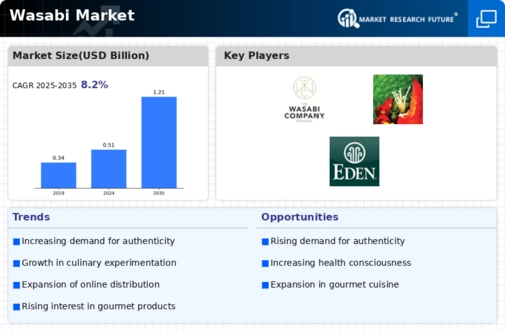Market Trends
Introduction
Wasabi industry is going to be a great business in 2025. It will be a big business because of the technological development, the changing regulatory environment, and the changing needs of consumers. Wasabi production efficiency is being improved by technological development, and the food hygiene regulations are getting stricter, and the wasabi industry is becoming more sustainable. The need for authentic and high-quality ingredients has also changed the product mix and the marketing strategy of the industry. The wasabi industry is strategically important for the stakeholder, not only because it has a significant influence on the positioning of the product, but also because it is necessary to be flexible in the product development and the management of the supply chain.
Top Trends
-
Sustainable Farming Practices
In the case of wasabi, the demand for a sustainable product is rising, and the wasabi market is moving toward sustainable production. Oregon Coast Wasabi is introducing organic farming methods, and yields have risen by as much as 20 percent. It is not only a higher-quality product, but also in line with the government’s policy of promoting sustainable agriculture. There may be a future in certifying wasabi as organic. -
Health and Wellness Focus
Wasabi is gaining in popularity, thanks to a growing awareness of its many health benefits, such as its anti-inflammatory properties. It also contains a substance that may help prevent cancer, and some companies are now promoting it for that very reason. This trend is supported by the fact that many health associations advocate including wasabi in the diet. The result is a shift in marketing strategy, with a greater emphasis on the health benefits. -
Diversification of Product Offerings
It is a question of extending the range of products to include sauces, snacks and condiments, and to a broader audience. For example, S&B Foods now produces wasabi-flavoured potato chips which have become very popular with young people. This trend reflects a strategic response to changing consumer preferences and may also result in innovations in product development. -
Technological Advancements in Cultivation
Agricultural technology, such as hydroponics and controlled environment agriculture, is revolutionizing wasabi cultivation. Companies like Pacific Coast Wasabi are using these methods to optimize growing conditions, resulting in higher quality wasabi. The trend is backed by the agricultural research institutes, which are promoting the adoption of new technology. Future improvements may include increased scalability and reduced costs. -
Global Expansion of Wasabi Consumption
Wasabi has a slanting obliqueness, and it is the first item in the wasabi market. It is a very popular product, and it is used in Europe and North America. Wasabi consumption in these two countries has increased by 15 percent. This is because Japanese cuisine is becoming popular. Seeing this trend, the companies are expanding their sales channels abroad, and the competition is expected to increase and the market will become saturated. -
E-commerce Growth
The number of people who buy wasabi on the Internet is increasing. Real Wasabi, LLC uses the Internet to reach a wider audience. This trend is reshaping distribution, and it may lead to a decrease in retail sales, which requires changes in logistics. -
Increased Focus on Authenticity
In recent years, as consumers have come to demand authentic wasabi products, the demand for genuine wasabi has increased. It is also the industry's advocacy of the transparency of the wasabi's origin that has contributed to this trend. The companies that can prove their authenticity will be able to compete more easily, and this is having a considerable impact on the branding and marketing strategies of companies. -
Culinary Innovation and Fusion Cuisine
In fusion cuisine, chefs are beginning to use wasabi in dishes that are not traditional. The trend is supported by industry insiders who are promoting new recipes. This trend may lead to new product lines and increased interest among consumers. -
Regulatory Changes and Food Safety Standards
Fortunately, the government has been tightening up on food safety, and this has forced wasabi producers to improve their quality control. This, of course, has pushed up production costs. But in the long run, the consumers’ confidence in the safety of the product will increase, and this is bound to have a positive influence on their purchasing decisions. -
Rise of Plant-Based Alternatives
The growing interest in vegetarian food is also affecting the wasabi market. There are companies that are using wasabi as a flavor enhancer in plant-based foods. The demand for a plant-based diet has increased and more and more companies are launching wasabi-based products. The implication for the future is that companies will have to increase R&D to develop new plant-based products.
Conclusion: Navigating the Wasabi Market Landscape
Approaching 2025, the wasabi market is highly competitive and fragmented, with a few established and many new companies vying for market share. The market is also growing in importance as consumers increasingly prefer wasabi produced locally and sustainably. This has prompted the industry to adjust its strategies. Brands with a history of innovation are focusing on niche marketing and niche distribution, while new companies are looking to establish themselves with the help of existing distribution channels. These companies are all attempting to combine the latest digital tools, such as AI for forecasting, automation for efficient production, and a commitment to sustainable practices. They are also trying to be as flexible as possible to respond to changes in consumer demand and market conditions, thereby ensuring their success in this evolving landscape.







Leave a Comment